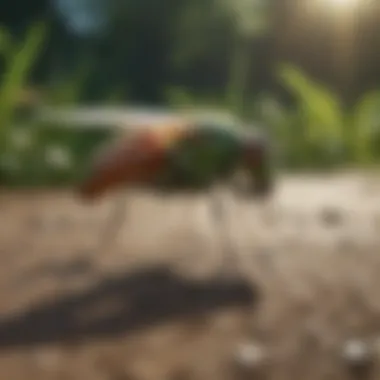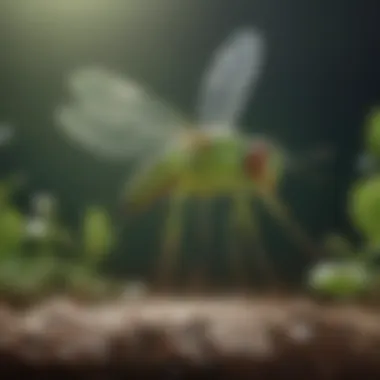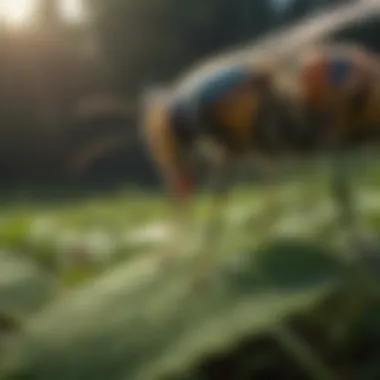Comprehensive Greenfly Repellent Strategies for Farmers


Intro
Effective pest management is crucial in sustainable agriculture. Among the various pests, greenflies (aphids) pose significant challenges to crop yields. To counter these infestations, farmers must adopt comprehensive greenfly repellent strategies. This article examines the relationship between agricultural practices and effective greenfly management, ensuring that environmental health is prioritized alongside productivity.
Research and Data Analysis
Understanding the landscape of modern agriculture and horticulture is fundamental in mitigating greenfly threats. Recent trends indicate a shift towards sustainable practices, with emphasis on eco-friendly solutions.
Latest Trends in Agriculture and Horticulture
As farmers become increasingly aware of the adverse effects of chemical pesticides, many are exploring alternatives. This has led to the emergence of a range of sustainable practices. Techniques such as organic farming, crop rotation, and companion planting are gaining traction. Not only do these methods reduce dependency on harmful chemicals, but they also create resilient ecosystems that deter pests naturally.
Statistical Insights into Crop Yields
Data shows that sustainable practices can lead to improved crop yields. For instance, farms that implement integrated pest management (IPM) can experience yield increases of up to 20% compared to those relying solely on chemical treatments. This highlights the importance of adopting comprehensive strategies that include understanding greenfly biology and ecology, which, in turn, influences crop health.
Best Practices and Techniques
Implementing effective strategies requires adaptability and awareness of best practices. Farmers can deploy various techniques tailored to their specific crops and contexts.
Efficient Crop Management Strategies
- Regular Monitoring: Continuously inspect crops for signs of infestation helps in early detection.
- Crop Rotation: Changing crop types in specific fields can disrupt pest cycles.
- Diverse Planting: Using multiple plant species can confuse pests and reduce their numbers.
Sustainable Horticultural Techniques
- Utilizing Natural Repellents: Ingredients such as neem oil and insecticidal soap are effective against greenflies.
- Encouraging Beneficial Insects: Ladybugs and lacewings feed on greenflies, providing a natural form of pest control.
- Organic Soil Amendments: Strengthening soil health with compost can increase plant resilience against pests.
Pest and Disease Management
Understanding common pests and their management plays a pivotal role in agricultural sustainability. Farmers need to recognize the signs and symptoms of pest-related issues.
Common Pests and Diseases in Crops
Greenflies are not the only threats, as several pests can severely impact crops. Farmers should be vigilant for:
- Thrips
- Whiteflies
- Spider mites
"Integrated pest management is not just a practice; it is a philosophy of agricultural sustainability."
Integrated Pest Management Strategies
IPM involves a combination of cultural, biological, and chemical control methods. Key components include:
- Cultural Control: Practices that disrupt pest life cycles, such as sanitation and habitat manipulation.
- Biological Control: Utilizing natural predators like parasitic wasps.
- Chemical Control: When necessary, applying targeted insecticides while favoring the least toxic options.
Understanding greenfly behavior and habitat enables farmers to strategically deploy these methods. With thorough planning and execution, agricultural practices can adaptively manage pests while maintaining ecological balance.
Understanding Greenfly: Biology and Behavior
Greenflies, commonly known as aphids, play a significant role in agricultural ecosystems. Understanding their biology and behavior is crucial for effective greenfly management strategies. This section explores the intricate details of greenflies, highlighting their definitions, lifecycle, and the impact they have on agriculture. By comprehending these elements, farmers can develop targeted solutions that align with sustainable agricultural practices.
Defining Greenfly
Greenflies are small, soft-bodied insects that belong to the family Aphididae. They are often present in various colors, including green, black, and gray. These pests are particularly notorious in the agricultural context due to their ability to reproduce rapidly and their proclivity for sucking sap from plants. They not only weaken plants but also transmit plant viruses, making their identification and management vital for farmers. Greenflies can be found on a wide range of plants, from vegetables to ornamentals. They are typically less than 0.5 cm in size, making them difficult to spot until infestations are severe.
Lifecycle of Greenfly
The lifecycle of greenflies is characterized by distinct stages: egg, nymph, and adult. The lifecycle begins with the fertilized eggs laid on host plants in the fall. These eggs hatch in the spring, leading to the emergence of nymphs. Unlike other insects, nymphs resemble smaller versions of adults – they do not undergo a metamorphosis. Nymphs develop rapidly, often reaching maturity within a week. Adult greenflies can reproduce asexually through parthenogenesis, creating live young rather than laying eggs. This reproductive strategy contributes significantly to their rapid population growth. Under optimal conditions, a single greenfly can produce up to 100 offspring every few weeks. Warm weather, ample food sources, and shelter from predators facilitate their proliferation.
Impact on Agriculture
The impact of greenfly infestations on agriculture can be severe. Primarily, they feed on the phloem of plants, leading to stunted growth, yellowing leaves, and reduced yield. Moreover, their feeding habits can cause stress in plants, making them more susceptible to diseases. Besides physical damage, greenflies are vectors for several plant viruses, which can spread infections across crops and lead to further economic losses. Farmers need to monitor greenfly populations closely to prevent substantial damage.


"Understanding greenflies and their influence on plant health is essential for maintaining sustainable farming practices."
In summary, a thorough understanding of greenfly biology and behavior is fundamental. It enables farmers to recognize infestations early and apply suitable management strategies that are environmentally friendly and efficient.
Identifying Greenfly Infestations
Identifying greenfly infestations is crucial for effective pest management in agriculture. Early detection allows farmers to respond quickly, minimizing damage to crops. Greenflies, or aphids, reproduce quickly, leading to potential population explosions if not managed efficiently. Understanding how to identify these infestations not only aids in protecting the current crop yield but also influences long-term sustainability in farming practices.
Symptoms of Infestation
Recognizing symptoms of greenfly infestations is the first step in effective management. Here are the most common signs that indicate a possible infestation:
- Wilting Leaves: Leaves may droop and curl, losing their firm structure.
- Discoloration: Affected plants often exhibit yellowing leaves, which can be a result of the sap draining.
- Sticky Residue: A sugary substance called honeydew is secreted by greenflies, leading to a sticky residue on leaves and surrounding areas.
- Sooty Mold: This mold grows on the honeydew, creating a blackened surface on foliage. It not only affects aesthetics but also photosynthesis.
Monitoring these symptoms can help in timely identification and intervention, reducing potential crop losses.
Monitoring Techniques
In addition to recognizing symptoms, farmers should employ effective monitoring techniques. These methods provide valuable information about the presence and extent of greenfly infestations. Here are some recommended techniques:
- Visual Inspections: Regular checks on plants can help spot the initial signs of infestation. Look closely under leaves and at the base of stems.
- Sticky Traps: Using yellow or blue sticky traps can capture flying greenflies and give an indication of their population density.
- Economic Thresholds: Determine a threshold for action based on the level of infestation. This helps prioritize responses effectively.
- Regular Monitoring Schedule: Establish a routine to inspect crops, perhaps weekly, to catch any sudden increases in pest populations.
"Timely identification of greenfly infestations empowers farmers to take action and sustain healthy crops."
Implementing these monitoring techniques fosters a proactive approach to pest management, ultimately leading to healthier crop conditions and yielding higher productivity.
Natural Repellents for Greenfly Control
Natural repellents play a crucial role in managing greenfly populations without harming the environment. Utilizing naturally sourced products ensures that agricultural practices remain sustainable and eco-friendly. These methods reduce chemical residues in crops, thus protecting soil health and biodiversity. The efficacy of natural repellents is often seen in their ability to disrupt greenfly behaviors, making them vital in an integrated pest management approach. This section explores several natural repellent options that are effective against greenfly infestations.
Essential Oils
Essential oils are gaining recognition for their pest-repelling properties. They are derived from plants and can serve as safe alternatives to synthetic pesticides. Not only are they effective, but they also come with additional benefits such as pleasant scents and low toxicity to non-target organisms.
Peppermint Oil
Peppermint Oil has been widely studied for its ability to deter greenflies. The strong aroma interferes with the insects' sensory receptors, making it difficult for them to locate their food sources. This unique feature is beneficial for farmers seeking to enhance their pest management practices without delving into chemical solutions.
Advantages of peppermint oil include its antimicrobial properties, which can also promote plant health. However, it is crucial to use this oil with care as concentrated amounts may cause phytotoxicity.
Tea Tree Oil
Tea Tree Oil stands out due to its broad-spectrum insecticidal properties. Its composition includes compounds that can disrupt the cellular processes of pests, leading to their eventual demise. This makes it a reliable choice for farmers aiming for effective control of greenfly populations.
The key characteristic of tea tree oil is its antifungal and antibacterial qualities, which provide added benefits to plant health. While it is an excellent alternative, it must be diluted appropriately, as high concentrations can harm plants.
Neem Oil
Neem Oil, extracted from the seeds of the neem tree, is another powerful natural repellent. It contains azadirachtin, a compound that disrupts the life cycle of insects. This includes interfering with molting and deterring feeding. Its effectiveness against various pests, including greenflies, makes it a popular choice among sustainable agriculture practitioners.
In addition to its pest control benefits, neem oil is biodegradable, further aligning with sustainable farming practices. However, its strong odor may be a disadvantage for some farmers and should be applied carefully to avoid harming beneficial insects.
Homemade Solutions
Homemade solutions provide accessible and low-cost alternatives for farmers facing greenfly infestations. They are simple to prepare, utilizing common household ingredients that are often safe for the environment. This section discusses two popular homemade solutions: soap and water mixture, and vinegar and water spray.
Soap and Water Mixture
A soap and water mixture is a well-proven method for controlling greenflies. By using mild liquid soap mixed with water, this solution suffocates greenflies upon contact, making it effective for immediate action. The key characteristic of this mixture is its ease of preparation and application, allowing farmers to produce and use it quickly during an infestation.
While effective, it is essential to monitor plants after application, as excessive soap can potentially cause damage by stripping away the protective waxy layers on leaves.
Vinegar and Water Spray


Vinegar and water spray is another straightforward homemade solution. The acetic acid in vinegar can kill greenflies on contact. This mixture is particularly favored for its dual function as a pest repellent and its role in aiding the cleaning of plant surfaces.
Like other homemade solutions, the simplicity of this spray makes it a popular choice among farmers. However, high concentrations of vinegar can also damage plant tissues, so careful dilution and patch testing are recommended before wide-scale application.
Natural repellents provide farmers with options that respect the ecosystem while effectively managing greenfly infestations. Employing these methods fosters a healthier agricultural environment.
Chemical Insecticides and Their Efficacy
Chemical insecticides play a critical role in controlling greenfly populations in agricultural settings. They offer a reliable solution when natural methods fall short. Understanding the efficacy of these insecticides is essential. It enables farmers to make informed decisions about pest control strategies. Additionally, proper use can minimize crop damage, leading to better yields and sustainable practices.
Types of Systemic Insecticides
Systemic insecticides are absorbed by plants, moving through their tissues and making them toxic to pests that feed on them. This characteristic provides a proactive approach in managing greenfly infestations. Common types include:
- Neonicotinoids: These are widely used due to their effectiveness against a range of sucking insects. They interfere with the insect's nervous system.
- Avermectins: This type has a strong impact on a variety of pests, including greenflies. They work by disrupting nerve signals.
- Pyridalyl: Effective against greenflies, this insecticide provides a different mode of action, helping to manage resistance.
Recognizing the different types can aid farmers in selecting the most suitable options for their specific situations.
Application Techniques
Proper application techniques are vital for maximizing the efficacy of systemic insecticides. Farmers should consider the following:
- Timing of Application: Apply insecticides early in the morning or late afternoon to reduce evaporation and degradation.
- Targeted Application: Use spot treatments to focus on areas of heavy infestation. This approach minimizes chemical use and environmental impact.
- Sprayer Calibration: Ensure equipment is calibrated correctly. This prevents under- or over-application, which can lead to ineffective control or harm non-target organisms.
Utilizing these methods ensures that insecticides are used effectively and responsibly.
Environmental Considerations
Using chemical insecticides carries environmental implications. Understanding these is essential for sustainable agriculture:
- Residue in Soil and Water: Some insecticides can remain in the environment long after application. This can affect soil health and nearby water sources.
- Non-target Species: There is always a risk of harming beneficial insects, such as pollinators and natural predators of pests.
- Resistance Management: Over-reliance on chemical controls may lead to resistance among pest populations, reducing their overall effectiveness.
Farmers need to weigh these considerations carefully. Sustainable pest management practices should balance efficacy with environmental stewardship.
Integrated Pest Management (IPM) Strategies
Integrated Pest Management (IPM) strategies play a crucial role in sustainable agricultural practices aimed at controlling greenfly populations. The essence of IPM lies in its holistic approach, blending various methods to manage pests while minimizing negative impacts on the environment. It emphasizes the need for informed decision-making, enhancing the efficacy of pest control measures while ensuring that agricultural practices remain sustainable.
Understanding how to implement IPM can significantly benefit farmers and agricultural enthusiasts. First, it fosters a proactive mindset, where one anticipates pest issues rather than reacting to them. This forward-thinking approach helps reduce infestation risks and aligns with ecological principles that support biodiversity.
Additionally, IPM encourages the use of multiple strategies. This integrated approach can lead to enhanced pest control, improved crop health, and increased yields. Moreover, it often results in decreased reliance on chemical insecticides, which is vital for sustainable farming.
Understanding IPM
IPM integrates biological, cultural, physical, and chemical tools to manage pest populations. The crux of IPM is its multifaceted nature, allowing for solutions tailored to specific pest issues. Successful IPM programs start with a thorough understanding of the pest, the affected crops, and the local ecosystem. Monitoring plays a pivotal role here; by tracking pest populations, farmers can determine when to intervene and which methods to use.
Farmers can adopt various techniques, such as deploying traps to catch greenfly or observing changes in plant health. Knowledge of pest life cycles and behavior informs the timing and choice of interventions. Thus, quite naturally, IPM aims to promote long-term sustainability within agricultural practices.
Cultural Practices
Cultural practices encompass a range of agronomic techniques that can significantly reduce greenfly infestations. These practices include crop rotation, selecting resistant varieties, and adjusting planting dates to evade peak infestation periods.
By rotating crops, farmers disrupt greenfly life cycles, thus decreasing the likelihood of significant outbreaks. Similarly, choosing pest-resistant plant varieties can lead to better resilience against infestations. This strategic planning is vital for maintaining crop health and ensuring effective pest management.
Other cultural techniques may involve optimizing soil health and utilizing proper irrigation methods, which can indirectly improve plant vigor and stress resistance, making them less susceptible to pest attacks.
Using Natural Predators
The introduction of natural predators is an effective strategy within IPM. Utilizing biological control agents helps maintain ecological balance while keeping greenfly populations in check.
Lacewings
Lacewings are especially valuable allies in controlling greenfly. These insects are known for their voracious appetite for aphids, including greenflies. Their larvae can consume a significant number of pests daily, making lacewings a favored option among those practicing sustainable agriculture.


A key characteristic of lacewings is their adaptability. They tend to thrive in various environments, enhancing their utility in different agricultural settings. However, their introduction requires careful management, as they also need a suitable habitat, which sometimes involves planting specific flowering plants that provide nectar. Generally, the advantages of lacewings far exceed the potential downsides, reinforcing their position as reliable pest controllers within IPM frameworks.
Ladybugs
Ladybugs, or ladybird beetles, are another powerful natural predator in the battle against greenfly. They are particularly renowned for their ability to consume large volumes of aphids, making them effective in pest control. Ladybugs are easily recognizable due to their distinctive coloration and are popular among farmers for their effectiveness.
A unique feature of ladybugs is their rapid reproduction rate. This means that once they are introduced into an environment, they can proliferate quickly, thereby enhancing their pest control capabilities. Despite their benefits, they can sometimes be challenging to control if their population exceeds the pest population. Nevertheless, their role as beneficial insects in managing greenfly infestations is largely acknowledged in the realm of sustainable agriculture.
The integration of natural predators like lacewings and ladybugs into IPM strategies not only controls pests effectively but also supports ecosystem health, making agriculture more sustainable in the long term.
Case Studies: Effective Greenfly Control
Exploring case studies is essential for understanding practical applications of greenfly control in real-world scenarios. These examples provide insights into the effectiveness of various strategies and highlight the factors that contribute to successful pest management. Analyzing such cases helps identify key elements such as environmental conditions, specific techniques used, and outcomes achieved. This knowledge is valuable for farmers and agricultural enthusiasts looking to enhance their pest management practices.
Farm A: Success with Natural Repellents
Farm A implemented natural repellents to combat greenfly infestations. The primary approach involved using essential oils from plants known for their repellent properties. Specifically, peppermint oil and tea tree oil were utilized due to their effectiveness. The farmers created a mixture of these oils with water and applied it to affected areas.
This strategy yielded positive results. The natural repellents not only reduced the greenfly population but also minimized harm to beneficial insects. Farmers noted a significant decrease in greenfly presence within weeks of application. This case demonstrates how the adoption of natural solutions can lead to successful pest control while supporting ecological balance.
Key Highlights from Farm A:
- Use of peppermint oil and tea tree oil as effective natural repellents.
- Significant reduction in greenfly population within a short period.
- Reduced impact on beneficial insects, maintaining overall ecosystem health.
Farm B: IPM Implementation
Farm B took a comprehensive approach using Integrated Pest Management (IPM) to address greenfly issues. The farm implemented various components of IPM, including cultural practices, biological control, and the targeted use of systemic insecticides only when necessary. This multi-faceted strategy aimed to create a balanced ecosystem that reduces reliance on chemical inputs.
One crucial aspect of Farm B's approach was the introduction of natural predators, such as lacewings and ladybugs. These insects played a vital role in controlling greenfly populations by preying on them. Regular monitoring allowed the farmers to evaluate the effectiveness of their methods and adjust strategies accordingly.
"Implementing IPM not only manages pests effectively, but it also promotes sustainability in agricultural practices."
Key Components from Farm B:
- Implementation of a multi-faceted IPM strategy.
- Use of lacewings and ladybugs as biological controls.
- Ongoing monitoring to refine pest management tactics.
Future Trends in Greenfly Management
The management of greenfly infestations is evolving. Farmers and agricultural enthusiasts must stay informed about new trends that emphasize sustainability and effectiveness. The future of greenfly management is crucial as it directly impacts crop yields and environmental health. Understanding these future trends will not only enhance the ability to control greenfly but also foster a more sustainable agricultural approach.
Research in Organic Alternatives
Recent years have seen a growing interest in organic alternatives for pest management. Research focuses on natural methods that do not degrade soil health or pollute water sources. Organic repellents, such as essential oils and plant extracts, offer promising results. Studies show that these substances can disrupt greenfly reproduction and feeding habits without harming beneficial insects.
- Efficacy: Research indicates increased effectiveness of certain organic compounds in repelling greenflies compared to traditional methods. For instance, extracts from garlic and marigold have shown some success.
- Safety: Organic alternatives are generally safer for the environment. They minimize chemical residues that can accumulate in the soil and crops, promoting better consumer health and market acceptance.
- Predictions: Continuous research may lead to the identification of additional organic solutions. Innovations around biopesticides that utilize naturally occurring microorganisms could also play a key role in future pest management strategies.
Technological Innovations
Technology is changing how pest management is approached. Innovations have introduced advanced tools for monitoring and controlling greenfly populations. These technologies can optimize pest management efforts.
- Smart Farming: Precision agriculture involves using data analytics and GPS technology. These tools help farmers identify infestation hotspots. This targeted approach allows for the efficient application of repellents, whether organic or chemical.
- Drones and Sensors: Drones equipped with imaging sensors can provide real-time data on crop health. Monitoring with drones enables farmers to detect early signs of greenfly infestations before they spread.
- AI and Machine Learning: Artificial intelligence can predict pest behavior based on weather patterns. Through machine learning, farmers can optimize their pest management practices by determining the best times to apply natural repellents or insecticides.
As technology advances, its integration into pest management becomes not just beneficial but necessary for sustainability.
End
In the pursuit of sustainable agricultural practices, the strategies for managing greenfly infestations play a critical role. The importance of these strategies cannot be overstated, as they provide farmers with tools to not only protect their crops but to do so in an environmentally friendly manner. In understanding the complex biology and behavior of greenfly, one can formulate effective control measures that minimize chemical use and ecological disruption.
Summary of Key Points
This article has covered several essential facets of greenfly management:
- Understanding Greenfly: A thorough review of their biological characteristics, lifecycle, and impact on agriculture helps farmers identify and address infestations effectively.
- Identification Techniques: Recognizing the signs of greenfly infestation is crucial for early intervention, which can significantly reduce crop damage.
- Natural Repellents: Essential oils like peppermint and tea tree oil can serve as effective alternatives to synthetic pesticides, providing a dual benefit of pest control while supporting ecological health.
- Chemical Insecticides: When necessary, the use of systemic insecticides should be done with an understanding of their environmental impact and best application practices.
- Integrated Pest Management: Employing IPM strategies fosters a holistic approach that combines various tactics for sustainable pest control.
- Future Trends: The importance of ongoing research in organic alternatives and technological innovations cannot be ignored. These advancements may lead to even more sustainable solutions.
The Importance of Sustainable Practices
Emphasizing sustainable practices in agriculture is vital for several reasons:
- Environmental Health: Sustainable methods help maintain soil health, promote biodiversity, and protect water sources.
- Economic Viability: By reducing reliance on chemical pesticides and incorporating natural options, farmers can cut costs and improve profitability over time.
- Consumer Demand: A growing number of consumers seek sustainably grown produce, making it advantageous for farmers to adopt these practices.
- Regulatory Compliance: Many regions implement strict regulations regarding pesticide usage. Sustainable practices can help farmers stay compliant while reducing liability risks.
- Future Resilience: Adopting sustainable practices today sets the stage for resilient agricultural systems that can adapt to changing climates and pest dynamics in the future.















